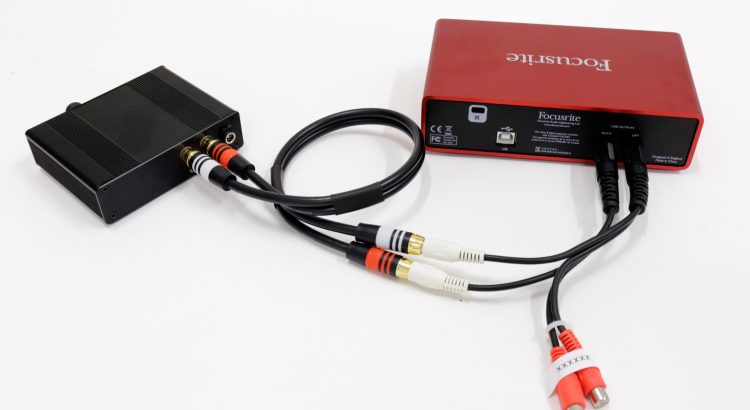Connecting a headphone amp to an audio interface might seem tricky. But it’s easier than you think.
Headphone amps can boost sound quality and volume. They are essential for detailed audio work. In this guide, you’ll learn how to properly connect these devices. Whether you are a beginner or an experienced audio enthusiast, this process is straightforward.
Understanding the connection helps you get the best audio experience. With clear steps, you can avoid common mistakes. Let’s dive into the basics and ensure your setup works perfectly. This guide is simple and practical, making it easy for anyone to follow. Get ready to enhance your audio setup with just a few steps.

Credit: www.elektronauts.com
Introduction To Headphone Amps
Headphone amplifiers, often called headphone amps, are vital in the audio world. They enhance the sound quality and volume of your headphones. This introduction will explore the purpose and benefits of headphone amps and their common use cases. Let’s dive in.
Purpose And Benefits
A headphone amp boosts audio signals. This makes sound clearer and more detailed. Many devices have built-in amps, but they are often not powerful enough. A dedicated headphone amp improves audio quality significantly.
Headphone amps help drive high-impedance headphones. These headphones require more power to deliver quality sound. With a headphone amp, you can enjoy better bass, treble, and overall sound.
Common Use Cases
Headphone amps are common in music production. Musicians and producers need accurate sound. They use headphone amps to mix and master tracks. This ensures every detail is audible.
They are also popular among audiophiles. These are people who love high-quality sound. Audiophiles use headphone amps for a superior listening experience. Gaming enthusiasts use them too. Clear audio can improve gameplay. Every sound detail counts in competitive gaming.
Understanding Audio Interfaces
Understanding audio interfaces is essential for connecting a headphone amp to your setup. Audio interfaces serve as the bridge between your computer and professional audio equipment. They convert analog signals to digital and vice versa. Knowing their features and types helps make informed decisions.
Key Features
Audio interfaces come with various features. Preamps are crucial. They amplify weak signals from microphones. High-quality preamps ensure clean, noise-free sound. Another feature is the number of inputs and outputs. More inputs allow for multiple instruments or microphones. Outputs let you connect speakers, headphones, and other devices.
Phantom power is another feature. It powers condenser microphones. Without phantom power, these microphones won’t work. Latency is also important. Low latency ensures no noticeable delay between input and output. Finally, consider the interface’s connection type. USB, Thunderbolt, and FireWire are common options.
Types Of Audio Interfaces
There are different types of audio interfaces. USB interfaces are popular. They are easy to use and work with most computers. Thunderbolt interfaces offer faster speeds. They are ideal for professional setups. FireWire interfaces are older but still reliable. They provide stable connections for audio work.
Some interfaces are portable. They are small and easy to carry. Ideal for musicians on the go. Desktop interfaces are larger. They offer more inputs and outputs. Suitable for home studios. Rack-mounted interfaces are for professional studios. They fit in standard racks and offer extensive connectivity options.
Essential Equipment
Connecting a headphone amp to an audio interface requires certain essential equipment. To ensure a smooth setup, you’ll need the right headphone amp and an appropriate audio interface. This section will guide you through selecting the necessary gear.
Choosing The Right Headphone Amp
First, determine the type of headphone amp you need. Consider your headphones’ impedance and sensitivity. High-impedance headphones require more power. Choose an amp that can provide sufficient power. Look for amps with low distortion for clear sound. Ensure the amp has the right input and output connections.
Selecting An Appropriate Audio Interface
Selecting the right audio interface is crucial. Ensure it has a headphone output and line outputs. Check for compatibility with your computer. Look at the number of inputs and outputs. More inputs allow for more devices. Consider the interface’s preamp quality. A good preamp ensures better sound quality. Look for low-latency performance. This reduces delay during recording and playback.
Connecting Your Devices
Connecting your headphone amp to an audio interface can enhance your listening experience. This guide provides a simple step-by-step process to help you achieve better sound quality. Let’s dive into the details of connecting your devices.
Required Cables And Adapters
Before you start, gather the necessary cables and adapters. These are essential for connecting your headphone amp and audio interface. Here’s what you need:
- Audio cables: Typically, you will need 1/4 inch TRS or XLR cables.
- Adapters: In some cases, you may need a 1/4 inch to 1/8 inch adapter.
- Power supply: Ensure your headphone amp has a power source.
Step-by-step Connection Guide
Follow these steps to connect your headphone amp to your audio interface:
- Turn off all devices: Safety first. Turn off your audio interface and headphone amp.
- Identify output ports: Locate the output port on your audio interface. This is usually labeled as “Line Out” or “Monitor Out”.
- Select the appropriate cable: Use the correct cable, such as a 1/4 inch TRS or XLR.
- Connect the cable: Plug one end of the cable into the output port of the audio interface.
- Find the input port: Locate the input port on your headphone amp. This is often labeled “Input” or “Line In”.
- Attach the cable: Connect the other end of the cable to the input port of the headphone amp.
- Power on the devices: Turn on your headphone amp and audio interface.
- Adjust settings: Set the volume and gain levels as needed. Start with low levels to avoid damage to your headphones.
By following these steps, you can enjoy improved sound quality through your headphone amp. Remember, proper connection ensures optimal performance of your audio equipment.
Configuring Settings
Configuring the settings is crucial when connecting a headphone amp to an audio interface. Proper settings ensure the best audio experience. Let’s dive into specific steps for adjusting audio levels and optimizing sound quality.
Adjusting Audio Levels
First, set the volume on the audio interface to a low level. This prevents sudden loud noises that can damage your ears. Next, adjust the headphone amp’s volume to your desired level. Make small adjustments to find the perfect balance. Ensure the audio interface output matches the headphone amp’s input requirements. Using mismatched levels can cause distortion.
Optimizing Sound Quality
Check the audio interface’s settings for any EQ or effects. Turn them off if you want a clean sound. Use high-quality cables to connect the devices. Poor cables can degrade sound quality. Ensure the headphone amp’s settings are set to neutral. This helps you hear the audio as intended.

Credit: www.reddit.com
Troubleshooting Common Issues
Connecting a headphone amp to an audio interface can improve sound quality. But sometimes issues can arise. Here are common problems and how to fix them.
No Sound Output
If there’s no sound, check your connections. Ensure cables are plugged in securely. Verify your headphone amp and audio interface settings. Sometimes, settings may reset after a power cycle. Also, check the volume levels. They might be too low or muted. Another tip: Try different cables to rule out a faulty one.
Distorted Audio
Distorted audio can ruin your listening experience. First, check the volume levels. High levels can cause distortion. Lower the volume on both devices and test again. Another common cause is interference. Keep your cables away from power sources. Use high-quality, shielded cables to minimize noise. Finally, check the gain settings. Ensure they are not too high, which can overload the input.
Advanced Tips And Tricks
Connecting a headphone amp to an audio interface can seem daunting. These advanced tips will help you get the best sound possible. Let’s dive into some specific tricks to enhance your audio setup.
Enhancing Audio Performance
Make sure your cables are high-quality. Low-quality cables can introduce noise. Place your headphone amp close to your audio interface. This minimizes signal loss.
Use balanced cables if your devices support them. Balanced cables reduce interference. Always check the gain settings. Proper gain levels prevent distortion. Experiment with different amp settings. Each setting can affect your audio’s tone.
Keep your equipment clean and dust-free. Dust can impact connections. Regularly update your audio interface’s firmware. New firmware can fix bugs and improve performance.
Using Multiple Headphone Amps
Sometimes you need more than one headphone amp. This is common in studios. Use a headphone splitter to connect multiple amps. Make sure the splitter is high-quality. Poor splitters can degrade sound quality.
Connect each amp to a different output on your audio interface. This allows separate mixes for each listener. Use identical headphone amps for consistent sound. Different amps can produce varying audio quality.
Adjust the volume levels on each amp. Make sure they match. This ensures a balanced listening experience. Label your connections. This helps you keep track of each setup. Test each connection before a recording session. This ensures everything works perfectly.

Credit: blog.jdslabs.com
Frequently Asked Questions
How Do I Connect A Headphone Amp To An Audio Interface?
To connect a headphone amp to an audio interface, use a TRS or RCA cable. Plug one end into the audio interface’s line output and the other end into the amp’s input. Ensure the volumes are set appropriately.
Why Use A Headphone Amp With An Audio Interface?
Using a headphone amp with an audio interface improves sound quality. It provides better power and clarity. This setup is especially beneficial for high-impedance headphones. It ensures accurate sound reproduction.
Can I Damage My Headphones Using An Amp?
Using a headphone amp properly will not damage your headphones. Ensure the amp’s output matches the headphones’ impedance. Avoid excessive volume levels to prevent damage.
What Cables Are Needed For Connection?
You need TRS or RCA cables to connect a headphone amp to an audio interface. Choose the appropriate cable based on your devices’ inputs and outputs. Ensure the cable is of good quality for optimal performance.
Conclusion
Connecting a headphone amp to an audio interface is simple. Follow the steps carefully. Make sure all cables are in place. Check for secure connections. Adjust the levels for clear sound. Test the setup with different audio tracks. Enjoy the enhanced audio experience.
This guide makes the process easy. Now, you can enjoy better sound quality. Share this knowledge with friends. Happy listening!
{ “@context”: “https://schema.org”, “@type”: “FAQPage”, “mainEntity”: [ { “@type”: “Question”, “name”: “How do I connect a headphone amp to an audio interface?”, “acceptedAnswer”: { “@type”: “Answer”, “text”: “To connect a headphone amp to an audio interface, use a TRS or RCA cable. Plug one end into the audio interface’s line output and the other end into the amp’s input. Ensure the volumes are set appropriately.” } } , { “@type”: “Question”, “name”: “Why use a headphone amp with an audio interface?”, “acceptedAnswer”: { “@type”: “Answer”, “text”: “Using a headphone amp with an audio interface improves sound quality. It provides better power and clarity. This setup is especially beneficial for high-impedance headphones. It ensures accurate sound reproduction.” } } , { “@type”: “Question”, “name”: “Can I damage my headphones using an amp?”, “acceptedAnswer”: { “@type”: “Answer”, “text”: “Using a headphone amp properly will not damage your headphones. Ensure the amp’s output matches the headphones’ impedance. Avoid excessive volume levels to prevent damage.” } } , { “@type”: “Question”, “name”: “What cables are needed for connection?”, “acceptedAnswer”: { “@type”: “Answer”, “text”: “You need TRS or RCA cables to connect a headphone amp to an audio interface. Choose the appropriate cable based on your devices’ inputs and outputs. Ensure the cable is of good quality for optimal performance.” } } ] }
